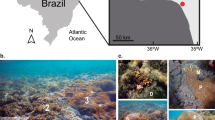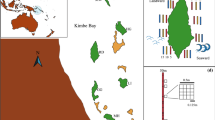Summary
A striking retardation of grwoth was observed in the scleractinian coralPavona cactus (Coelenterata: Scleractinia) growing in the vicinity of the soft coralSinularia flexibilis (Coelenterata: Alcyonacea). More extensive field observations of naturally occurring interactions between soft corals and scleractinian corals suggested that members of the former group can be the more effective competitors for space on hard substrate. To test this hypothesis, colonies of three soft corals,Lobophytum pauciflorum, Sinularia pavida, andXenia sp. aff.danae, were relocated next to stands of two hard corals,Pavona cactus andPorites andrewsi (=Porites cylindrica), and compared with undisturbed control areas. In areas where soft corals and scleractinian corals were in direct contact, significantly high levels of local mortality in the latter occurred in three of the six interaction pairs. One soft coral,L. pauciflorum, also caused extensive and significant mortality inPorites andrewsi in a non-contact situation. The scleractinian corals had no effect on the soft corals considered here. These results indicate that soft corals can effectively compete for space against hard corals. Furthermore, it is inferred that toxic exudates from the soft coral might be responsible for causing localized mortality in hard corals, since extensive mortality occurred in certain cases in the absence of contact. Competitive abilities of soft corals in interactions with hard corals varied in a species-specific manner. Susceptibility of hard corals to competitive mechanisms utilized by soft corals, particularly allelopathic ones, likewise varied species-specifically. It is commonly believed that the adaptive value of toxic compounds in soft corals stems from their effectiveness as a chemical defence mechanism in predator-prey interactions. This study has demonstrated their further role as allelopathic agents in interspecific competitive interactions.
Similar content being viewed by others
References
Bakus GJ (1971) An ecological hypothesis for the evolution of toxicity in marine organisms. In: De Vries A, Kochva E (eds) Toxins of animal and plant origin, vol 1. Gordon & Breach, London, pp 57–62
Bakus GJ (1974) Toxicity in holothurians: a geographical pattern. Biotropica 6:229–236
Bakus GJ (1976) The biology and ecology of tropical holothurians. In: Jones OA, Endean R (eds) Biology and geology of coral reefs, vol 2. Academic Press, New York London, pp 325–367
Bakus GJ (1981) Chemical defense mechanisms on the Great Barrier Reef, Australia. Science 211:497–499
Bakus GJ, Green G (1974) Toxicity in sponges and holothurians: geographic pattern. Science 185:951–953
Bakus GJ, Thun MA (1979) Bioassays on the toxicity of Caribbean sponges. Colloq Int CNRS 291:417–422
Barnes RD (1974) Invertebrate zoology, 3 edn. Saunders, Philadelphia, pp 134–136
Benayahu Y (1975) Quantitative characteristics of community structure of stony corals, soft corals, and algae in the northern Gulf of Eilat (Red Sea). M.Sc. thesis, University of Tel-Aviv, Israel
Benayahu Y, Loya Y (1977) Space partitioning by stony corals, soft corals, and benthic algae on the coral reefs of the northern Gulf of Eilat (Red Sea). Helgol Wiss Meeresunters 30:362–382
Benayahu Y (1981) Competition for space among coral-reef sessile organisms at Eilat, Red Sea. Bull Mar Sci 31:514–522
Brown WL Jr, Eisner T, Whittaker RH (1970) Allomones and kairomones: transspecific chemical messengers. Bioscience 20:21–22
Cameron AM (1974) Toxicity phenomena in coral reef waters. Proc 2nd Int Coral Reef Symp Brisbane, vol 1, pp 513–518
Cameron AM (1976) Toxicity of coral reef fishes. In: Jones OA, Endean R (eds) Biology and geology of coral reefs, vol 3. Academic Press, New York London, pp 155–176
Coll JC (1980) Soft coral research at the James Cook University of North Queensland. Proc 4th Asian Symp Med Plants Spices, Bangkok, UNESCO Spec Publ 1981, pp 197–204
Coll JC, Bowden BF, Mitchell SJ (1980) Marine natural products chemistry at the James Cook University of North Queensland. Chem Aust 47:259–263
Coll JC, Bowden BF, Tapiolas DM, Dunlap WC (1982a) In situ isolation of allelochemicals released from soft corals (Coelenterata: Octocorallia): a totally submersible sampling apparatus. J Exp Mar Biol Ecol 60:293–299
Coll JC, La Barre S, Sammarco PW, Williams WT, Bakus GJ (1982b) Chemical defences in soft corals (Coelenterata: Octocorallia) of the Great Barrier Reef: a study of comparative toxicities. Mar Ecol Prog Ser 8:271–278
Connell JH (1961) Effects of competition, predation byThais lapillus, and other factors on natural populations of the barnacleBalanus balanoides. Ecol Monogr 31:61–104
Dayton PK (1971) Competition, disturbance, and community organization: the provision and subsequent utilization of space in a rocky intertidal community. Ecol Monogr. 41:351–398
Gove PB (ed) (1976) Webster's 3rd New International Dictionary. G. and C. Merriam Co., Springfield, Mass., p 55
Hildemann WH (1974) Some new concepts in immunological phylogeny. Nature (London) 250:116–120
Hildemann WH (1979) Immunocompetence and allogeneic polymorphism among invertebrates. Transplantation 27:1–3
Hildemann WH, Jokiel PL, Bigger CH, Johnston IS (1980) Allogeneic polymorphism and alloimmune memory in the coralMontipora verucosa. Transplantation 30:297–301
Hildemann WH, Linthicum DS, Vann DC (1975a) Immunoincompatibility reactions in corals. In: Hildemann WH, Benedict AA (eds) Immunologic phylogency. Plenum, New York, pp 105–114
Hildemann WH, Linthicum DS, Vann DC (1975b) Transplantation and immunocompatibility reactions among reef-building corals. Immunogenetics 2:269–284
Hildemann WH, Raison RL, Cheung, G, Hull CJ, Akaka L, Okamoto J (1977a) Immunological specificity and memory in a scleractinian coral. Nature (London) 270:219–223
Hildemann WH, Hull CJ, Akaka LK, Okamoto J, Cheung GP (1977b) Tissue transplantation immunity in corals. Proc 3rd Int Coral Reef Symp Miami, vol 1, pp 538–543
Jackson JBC (1977) Competition on marine hard substrata: the adaptive significance of solitary and colonial strategies. Am Nat 111:743–767
Jackson JBC, Buss L (1975) Allelopathy and spatial competition among coral reef invertebrates. Proc Nat Acad Sci 72:5160–5163
Johnston IS, Jokiel PL, Bigger CH, Hildemann WH (1981) The influence of temperature on the kinetics of allograft reactions in a tropical sponge and a reef coral. Biol Bull 160:280–291
Kittredge JS, Takahashi FT, Lindsey J, Lasker R (1974) Chemical signals in the sea: marine allelochemics and evolution. Fish Bull 72:1–11
Lang JC (1971) Interspecific aggression by scleractinian corals. I. The rediscovery ofScolymia cubensis (Milne Edwards & Haime). Bull Mar Sci 21:952–959
Lang JC (1973) Interspecific aggression by scleractinian corals. II. Why the race is not only to the swift. Bull Mar Sci 23:261–279
Lucas CE (1947) The ecological effects of external metabolites. Biol Rev 22:270–295
Lucas CE (1949) External metabolites and ecological adaptations. Symp Soc Exp Biol 3:336–356
Lucas CE (1955) External metabolites in the sea. Pap Mar Biol Oceanogr Deep-Sea Res [Suppl] 3:139–148
McNaughton SJ, Wolf LL (1979) General ecology, 2nd edn. Holt, Rinehart & Winston, New York, p 685
Muller CH (1966) The role of chemical inhibition (allelopathy) in vegetational composition. Bull Torrey Bot Club 93:332–351
Muller CH, Hanawalt RB, McPherson JK (1968) Allelopathic control of herb growth in the fire cycle of California chaparral. Bull Torrey Bot Club 95:225–231
Ne'eman I, Fishelson L, Kashman Y (1974) Sarcophine — a new toxin from the soft coralSarcophyton glaucum (Alcyonaria). Toxicon 12:593–598
Nishihira M (in press) Interactions of Alcyonaria with hermatypic corals on an Okinawan reef flat. In: Gomez E (ed) The reef and man. Proc 4th Int Coral Reef Symp Manila
Paine RT (1966) Food web complexity and species diversity. Am Nat 100:65–75
Raison RL, Hull CJ, Hildemann WH (1976) Allogenic graft rejection inMontipora verrucosa a reef-building coral. In: Wright RK, Cooper EL (eds) Phylogeny of T and B cells. North Holland, Amsterdam, pp 3–8
Ricklefs RE (1979) Ecology, 2nd edn. Chiron Press, New York, p 864
Saunders GW (1957) Interrelations of dissolved organic matter and phytoplankton. Bot Rev 23:389–409
Sheppard CRC (1979) Interspecific aggression between reef corals with references to their distribution. Mar Ecol Prog Ser 1:237–247
Sheppard CRC (1982) Coral populations on reef slopes and their major controls. Mar Ecol Prog Ser 7:83–115
Sokal RR, Rohlf FJ (1969) Biometry. Freeman, San Francisco
Theodor JL (1971) Reconnaissance du “self” ou reconnaissance du “not-self”. Arch Zool Exp Gen 112:113–116
Theodor JL (1975) Comment les gorgones distinuent le “soi” du “non-soi”. La Recherche 6:573–575
Tursch B, Braekman JC, Daloze D, Kaisin M (1978) Terpenoids from coelenterates. In: Scheuer PJ (ed) Marine natural products: chemical and biological perspectives, vol 2. Academic Press, New York London, pp 247–296
Weinheimer AJ, Matson JA, Bilayet Horsain M, van der Helm D (1977) Marine anticancer agents sinularin and dihydro-sinularin, new cembranolide diterpenes from the soft coralSinularia flexibilis. Tetrahedron Lett 1977:2923–2926
Whittaker RH, Feeny PP (1971) Allelochemics: chemical interactions between species. Science 171:757–770
Wolanski E, Jones M (1980) Water circulation around Britomart Reef, Great Barrier Reef, during July 1979. Aust J Mar Freshwater Res 31:415–430
Author information
Authors and Affiliations
Rights and permissions
About this article
Cite this article
Sammarco, P.W., Coll, J.C., La Barre, S. et al. Competitive strategies of soft corals (Coelenterata: Octocorallia): Allelopathic effects on selected scleractinian corals. Coral Reefs 1, 173–178 (1983). https://doi.org/10.1007/BF00571194
Received:
Accepted:
Issue Date:
DOI: https://doi.org/10.1007/BF00571194




